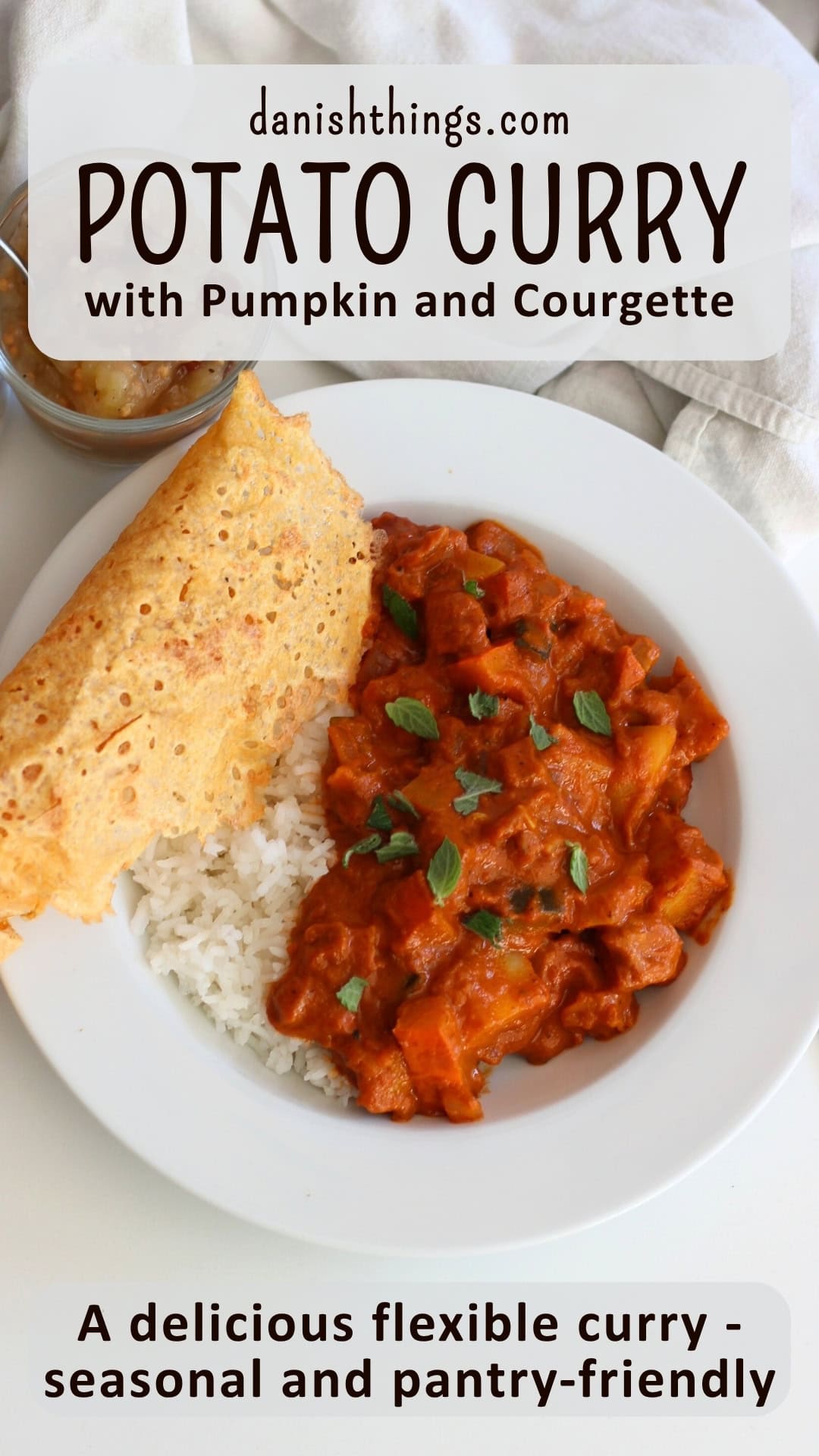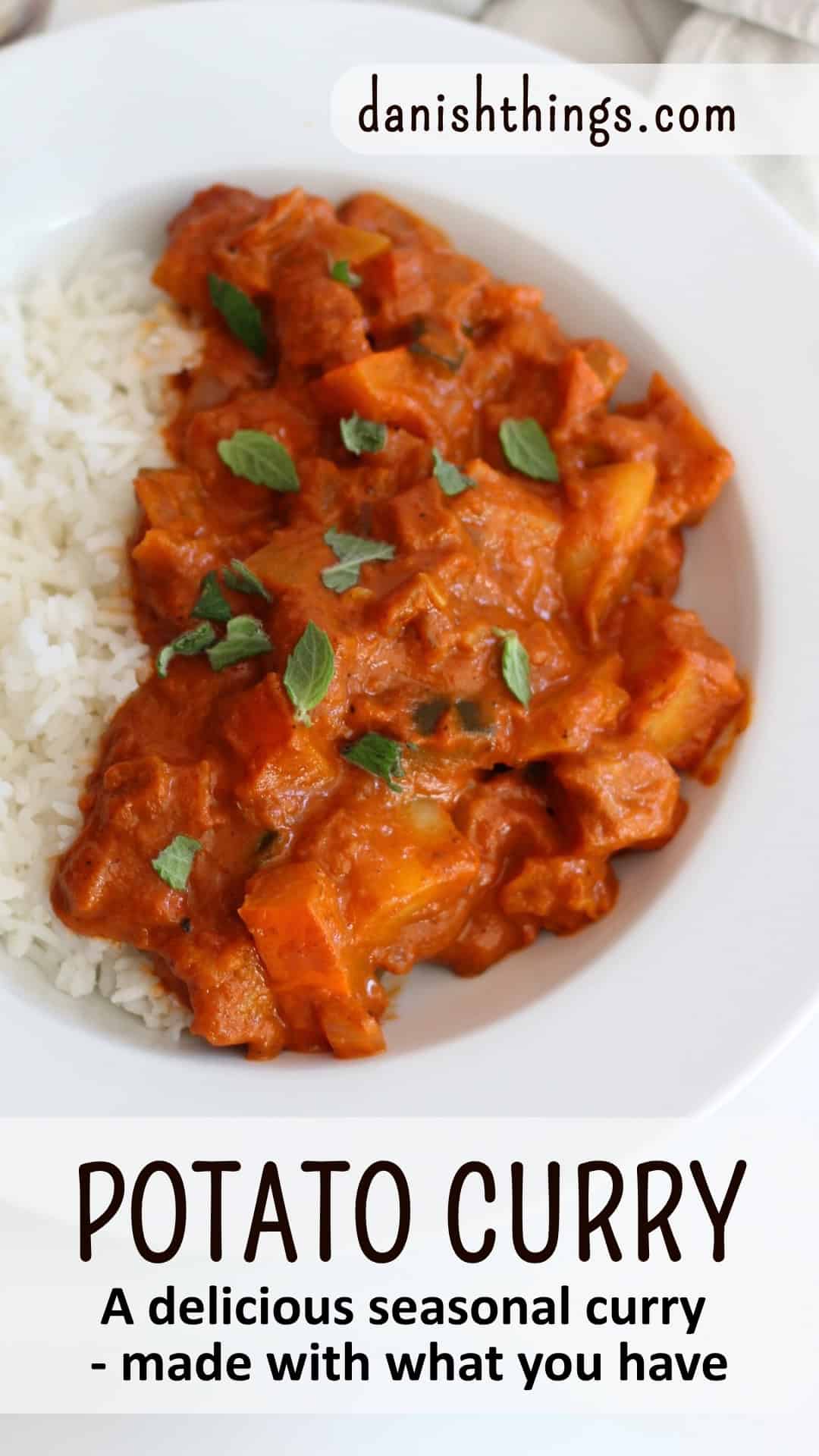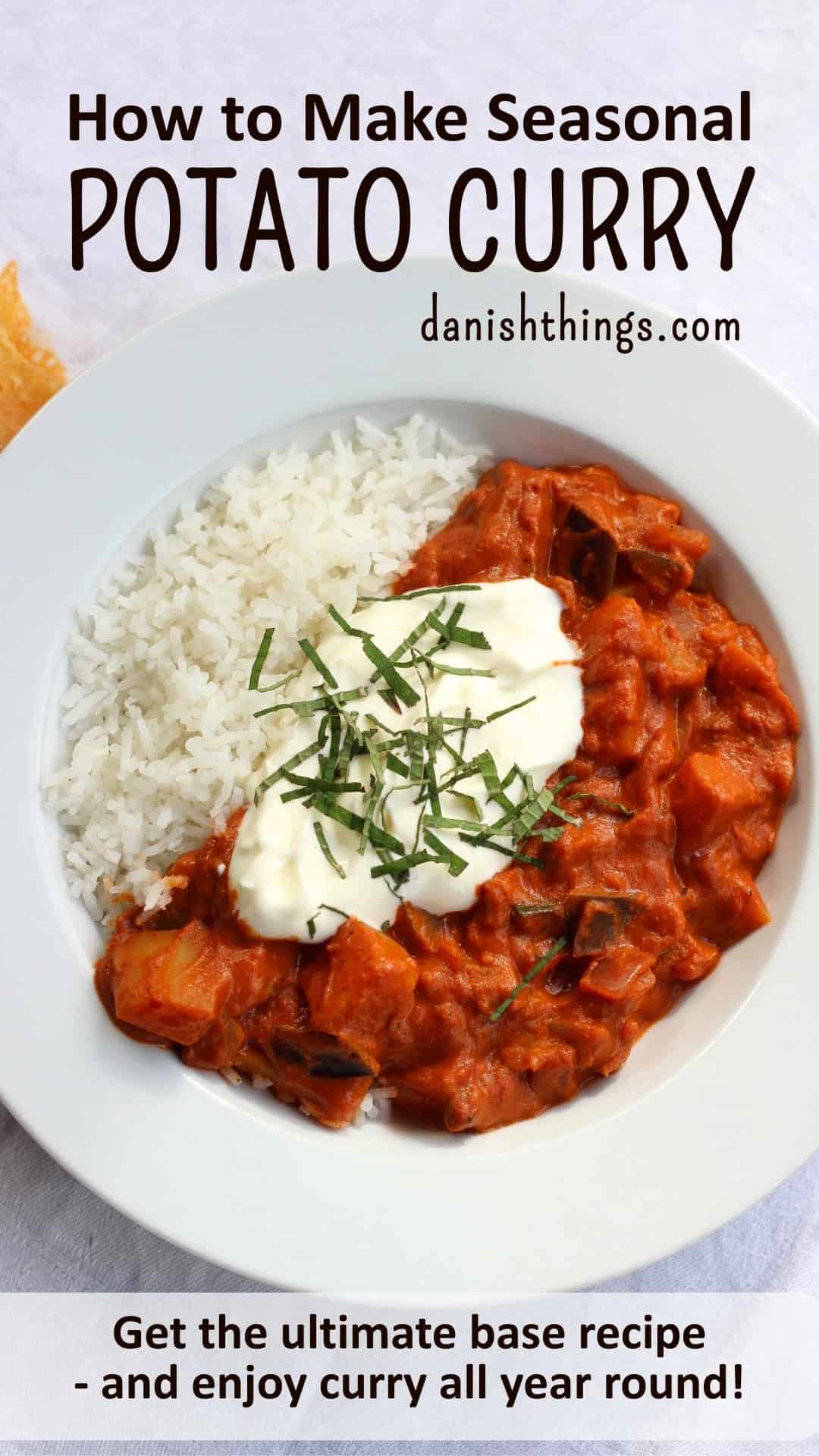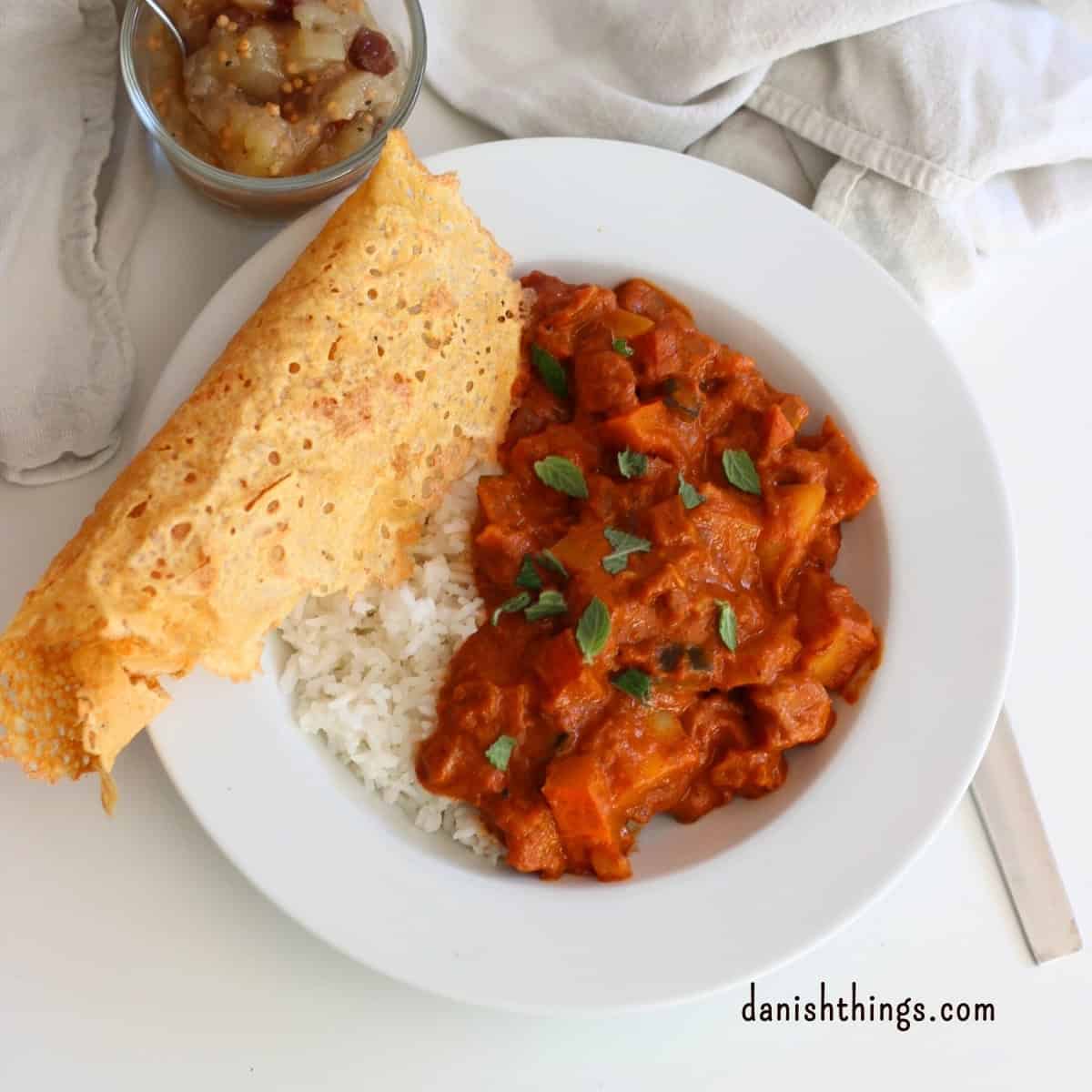Potato Curry with Pumpkin and Courgette (Zucchini) – or other Seasonal Vegetables
This is my favourite potato curry recipe.
It’s a favourite because it:
- first and foremost, tastes incredible
- is filling
- is reasonably healthy
- can be varied in SO many ways
You get the recipe for potato curry with pumpkin and courgette (zucchini).
Although my original title was actually “Potato Curry with…?”
Because it’s a curry you can make with aubergine (eggplant), cauliflower, and whatever else is hiding in the vegetable drawer – if it’s not pumpkin and courgette season right now.
And this makes this potato curry an obvious – cheaper and more flexible – alternative on meat-free days.
Contents – jump directly to what you’re interested in:
- Autumn Curry – adaptable to the changing year
- Serve your curry with optional side dishes
- Vary your potato curry – about the tables and cooking times
- Alternatives to pumpkin and courgette
- Supplementary vegetables
- Supplementary proteins
- Spices
- Seasonal curry suggestions
- The Recipe: How to make potato curry
- Share your favourite curry

Autumn Curry – adaptable to the changing year
Right now, as I’m writing this, there are plenty of courgettes (zucchinis) and pumpkins in the shops – and the weather outside is perfect for hearty curries.
This potato curry has also been in steady rotation for the last few weeks.
The star of this curry is the potato.
The good thing about potatoes is that they are relatively cheap, taste good, keep you full for a long time – and they contain few calories.
Potatoes are also so neutral in flavour, so they pair well with other vegetables.
So what you get is the recipe for a basic potato curry.
A delicious and flavourful vegetarian curry – a recipe you can vary by season or pantry.
The recipe is a great starting point for experimenting with vegetables, fillings, and spices.
Even though it’s a curry I’ve made SO many times, I never serve the exact same dish.
Because you can vary it in so many ways.
But the recipe for potato curry with pumpkin and courgette is one of the favourites.
Please feel free to share your favourite with the rest of us – write it in the comments below.
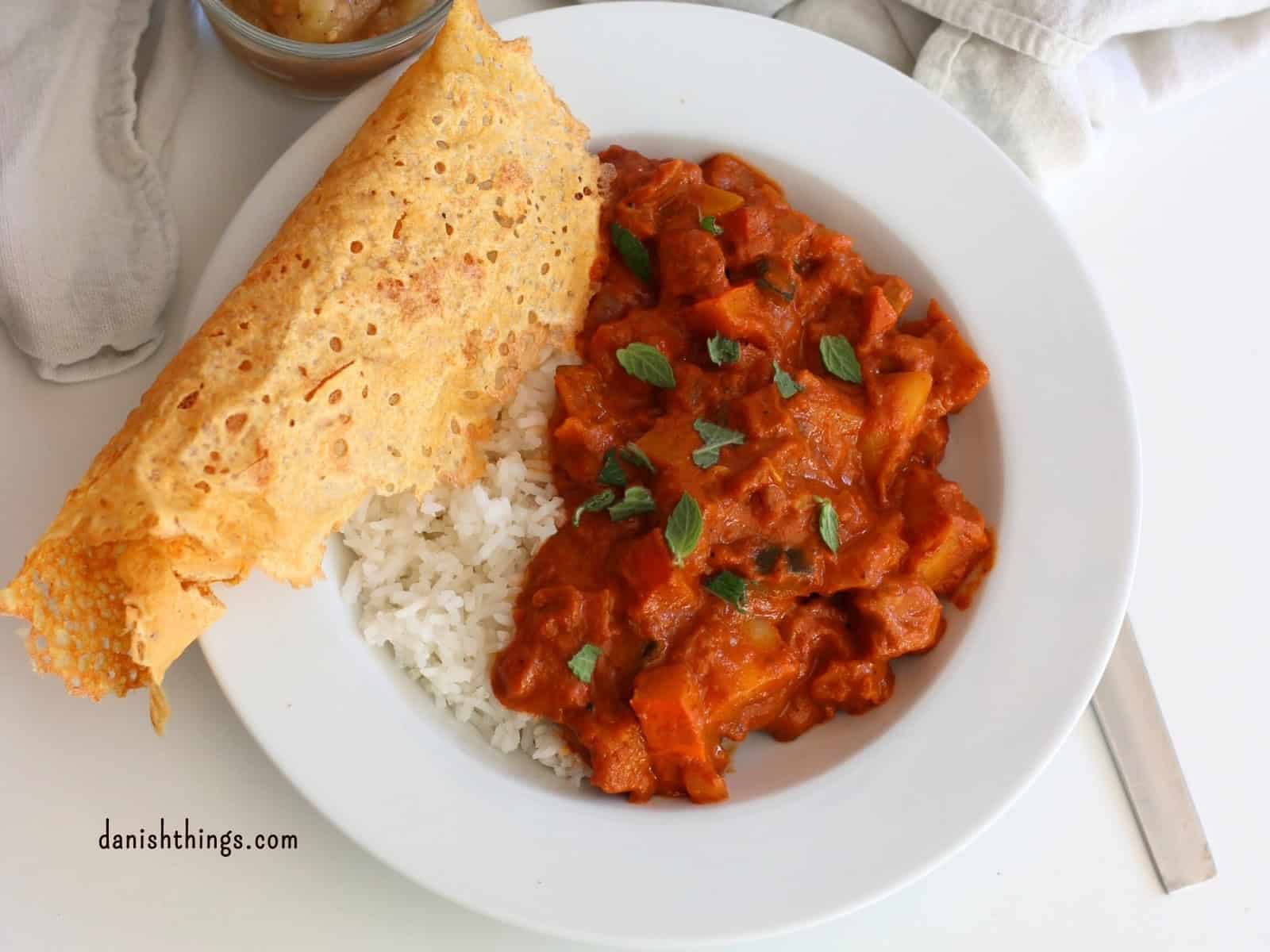
Serve your curry with optional side dishes
Potato curry is a versatile dish that can be made and served as a stand-alone main course.
Making potato curry with courgette and pumpkin, and eating it without side dishes, yields a low-calorie curry – even with full-fat coconut milk.
I usually eat it with rice, changing other sides based on what’s in the pantry or fridge.
I have listed some suggestions:
The Basics
- Rice – a classic and neutral accompaniment – choose your favourite
- Flatbreads – e.g., naan, chapati, or homemade flatbreads – perfect for soaking up the last of the sauce
- Savoury Pancakes – Dosa-inspired or made from chickpea flour, lentil flour, or a mix – use them as wraps or as an alternative to bread
Contrast
- Yoghurt or Raita – cooling and creamy contrast – Greek yoghurt 10% is good if your curry is spicy. You can also mix the yoghurt with citrus, fresh herbs or spices, or make raita – e.g., a version with cucumber and mint
- Chutney – store-bought or homemade – choose mango, apple, plum… – chutney adds a good mix of sweetness, acidity, and heat
Topping
- Fresh Herbs – mint, coriander (cilantro), chervil, parsley… use the herbs you have and that suit the dish
- Crunch – papadums are the obvious crispy accompaniment – you can also use roasted chickpeas, nuts or seeds, e.g., sesame, pumpkin, or nigella
Chef Yotam Ottolenghi often recommends a crisp crunch for his curry dishes – including “Potato Stick Crisps” and “Crispy Fried Onions” – I haven’t tried them yet – please write a comment if you have.
The curry dish is well suited for everyday meals – it looks after itself and can be made well in advance.
It’s also great as leftovers – in savoury pancakes, with rice, or as it is.
You can serve potato curry when you have guests – choose a few more side dishes if you like.
Or you can serve the dish as a bowl or vegetarian buffet-style meal.
Use the suggestions above and add a little shredded cabbage, cucumber, tomato, mango, radishes, or thinly sliced carrots – to get extra crispness and freshness.
You can also add extra toppings: coconut, pomegranate seeds, (sweet) chilli sauce…
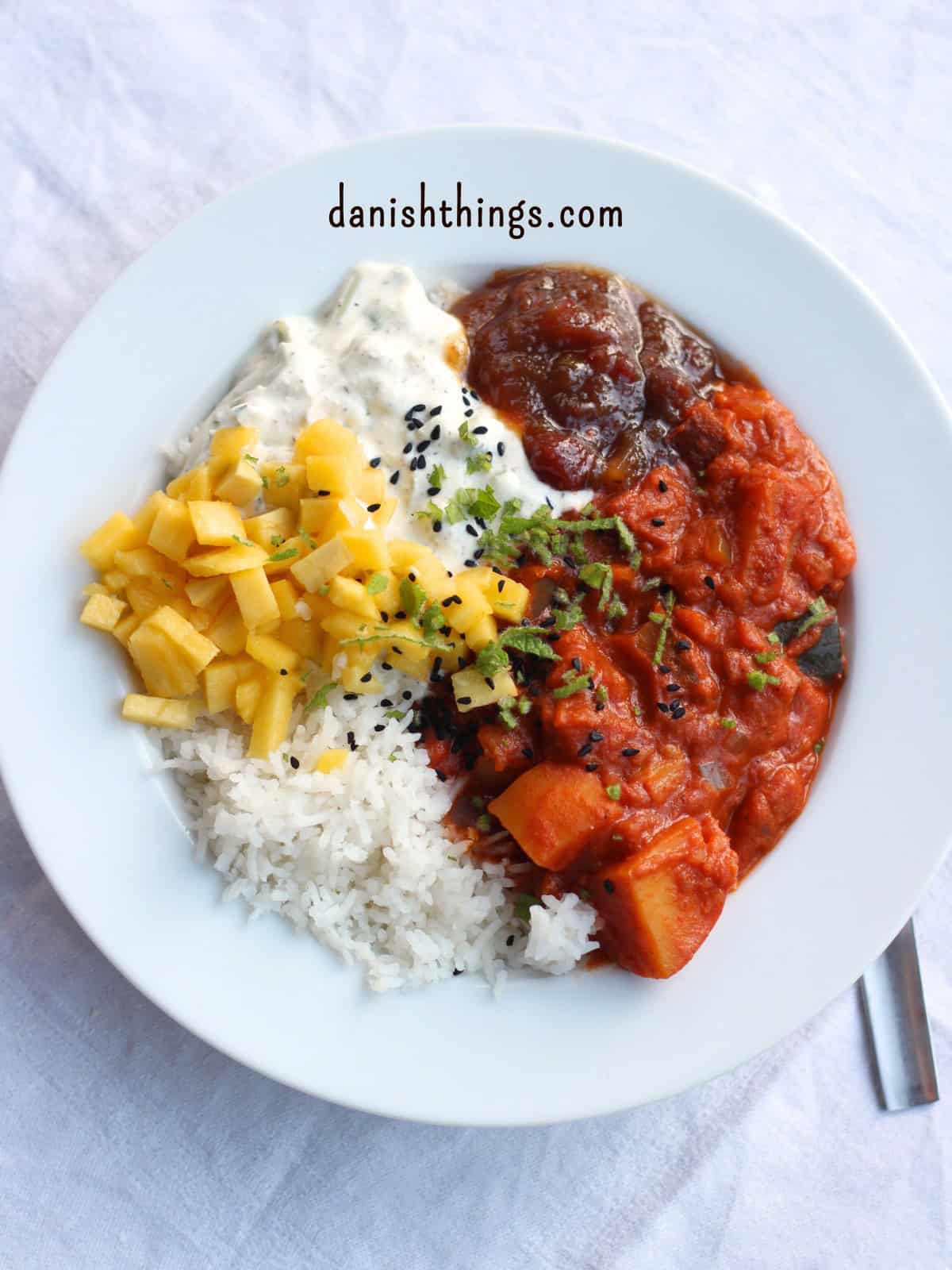
Vary your potato curry – about the tables and cooking times
The recipe is intended as a basic potato curry, designed so you can swap in seasonal vegetables as alternatives or additions to pumpkin and courgette.
To make it easy to adapt the curry recipe, I have created three tables that briefly describe the taste, texture, and benefits they bring to a curry.
- Alternatives to pumpkin and courgette
Vegetables with body and structure that can replace or supplement the base ingredients - Supplementary vegetables
Adds colour, flavour, and variation. They cannot stand alone as a substitute for pumpkin and courgette, but they can be mixed with each other and vegetables from table 1 - Supplementary proteins
Used if you want to give the dish more substance, change the flavour profile, or omit rice and savoury pancakes/bread
I have created a star code that indicates the cooking time:
- ★★★ = long (30-40 min)
- ★★ = medium (15-25 min)
- ★ = short (5-10 min)
The cooking times are guidelines – some prefer “al dente” vegetables and others like them completely cooked through – so cook the vegetables as you like them.
For example, I like courgette and aubergine to be completely soft and soaked up lots of flavour, so I add them together with the potatoes.
However, I like carrots with more bite, so I wait to add them.
The Weight of the Vegetables
When baking cakes, it is essential to follow the precise instructions and measure the correct grams – this is not as crucial in curries.
Vegetables weigh differently depending on the season.
If I have written 250g of pumpkin, which you want to replace with an aubergine that weighs 315g, then use the 315g – unless you have plans for the rest of it in another dish later in the week.
If you are missing vegetables, you can check if you have any of the ones I suggested below.

Alternatives to Pumpkin and Courgette
These vegetables can replace pumpkin and courgette in the basic potato curry – adding substance, structure, and flavour.
| Vegetable | Flavour and Texture | Benefit in Curry |
|---|---|---|
| Celeriac ★★★ | Earthy and intense with a firm structure | Adds umami and depth – develops flavour with long simmering |
| Aubergine (Eggplant) ★★★ / ★★ | Earthy and meaty – soaks up liquid and flavour | Absorbs spices – becomes soft and creamy with long simmering |
| Parsley Root ★★ | Mild and slightly sweet with a firm bite | Melts into the sauce – best with medium to long simmering |
| Parsnip ★★ | Aromatic and subtly sweet with a firm texture | Adds depth and body — balances spices during medium to long simmering |
| Sweet Potato ★★ | Sweet and soft – becomes creamy when simmered | Adds body and sweetness – balances bold spices |
| Carrot ★★ / ★ | Sweet and firm with a juicy bite – depends on dice size | Adds colour and sweetness – can be simmered or added later for structure |
Tips
- Choose at least one vegetable with body and structure, and supplement with other vegetables
- Cut them into appropriate sizes so they become tender at the same time
- Combine sweet and earthy flavours for added depth
- If using aubergine, let it simmer for a long time – it absorbs flavour and turns creamy
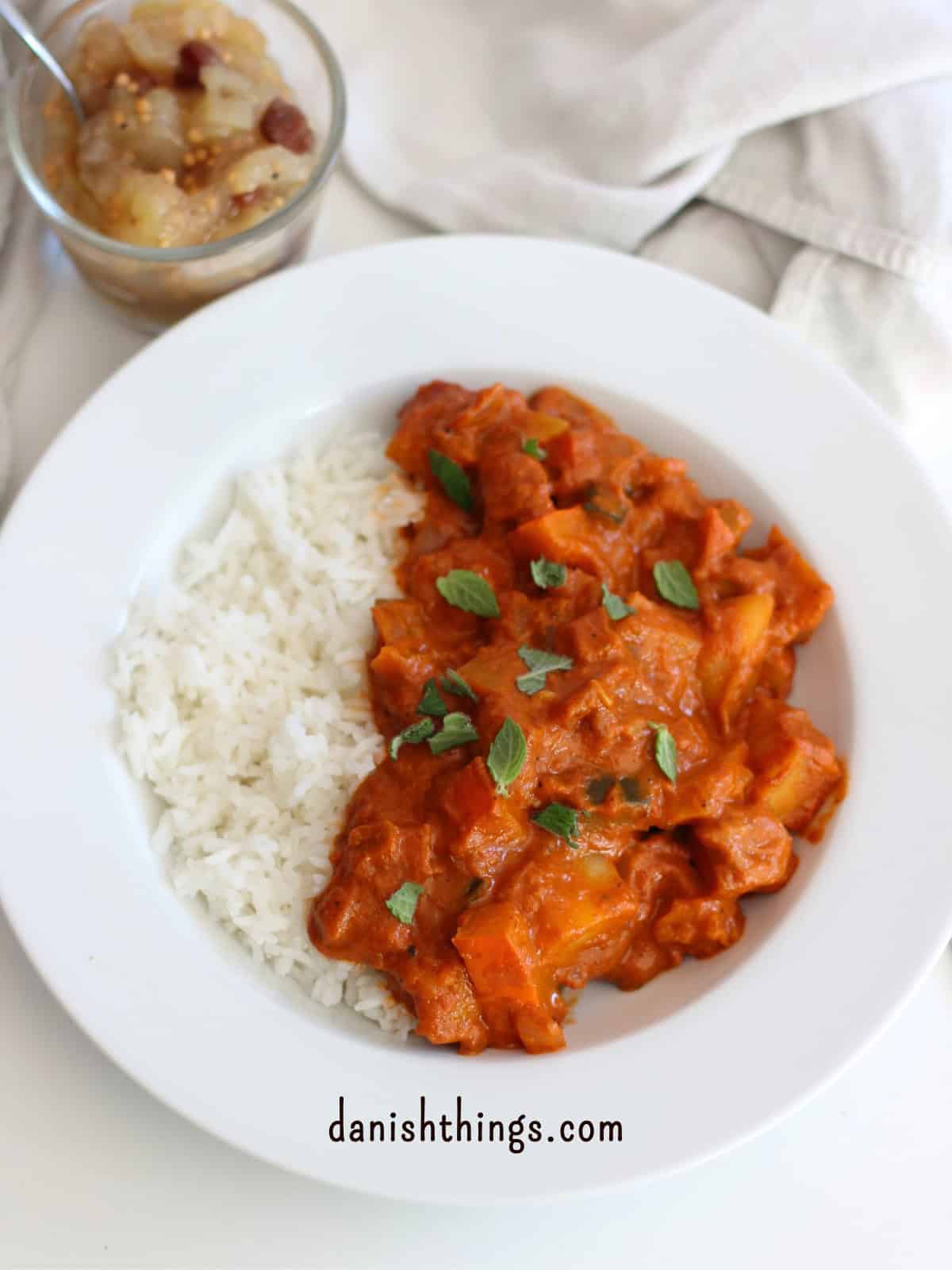
Supplementary Vegetables
These vegetables can supplement pumpkin and courgette – or vegetables from table 1 – in the basic potato curry – and add colour, flavour, or variation in texture.
| Vegetable | Flavour and Texture | Benefit in Curry |
|---|---|---|
| Kale Stem/Stalks ★★★ | Robust and fibrous — requires long cooking | Adds structure and depth — best added early |
| Leek ★★★ / ★★ | Mild and slightly sweet — softens when simmered | Complements onion as a base — adds aromatic depth and creamy sweetness |
| Cauliflower ★★ | Mild and firm – florets soften quickly, the stem takes a little longer | Retains structure – absorbs spices evenly |
| Bell Pepper (Capsicum) ★ | Sweet and juicy – softens when simmered | Adds freshness and colour |
| Tomato (Fresh) ★ | Acidic and juicy – breaks down when simmered | Adds liquid and acidity – balances richness and spices |
| Kale (Leaves) ★ | Soft and green – wilts quickly | Adds colour and texture – best added near the end |
| Green Beans (Fresh/Frozen) ★ | Fresh and crisp – quickly lose their bite when cooked | Adds green colour and bite – best added near the end |
| Broccoli (Florets) ★ | Slightly bitter and firm – easily overcooked | Adds colour and variation – best added near the end |
| Spinach (Fresh/Frozen) ★ | Mild and soft – wilts quickly | Adds green colour and soft texture – best added near the end |
| Sweetcorn (Canned/Frozen) ★ | Sweet and juicy – firm texture, fresh sweetcorn needs slightly longer cooking | Adds colour, sweetness, and bite – pairs well with chilli and coconut |
| Peas (Fresh/Frozen) ★ | Sweet and crisp – lose colour and texture with prolonged cooking | Adds sweetness and green colour – best added last and warmed through |
Tips
- Use 2-3 vegetables (or more) for colour and variation
- Add them in stages – ★★★ first, ★★ after 10-15 minutes, and ★ at the end
- Frozen vegetables do not need to be thawed – they can go straight into the pot
- Fresh vegetables best retain colour and bite when only warmed through – for a softer result, cook them longer

Supplementary Proteins
You can add these proteins to your potato curry – if you want extra texture and fullness.
| Protein | Flavour and Texture | Benefit in Curry |
|---|---|---|
| Green Lentils (Dried) ★★★ | Firm and slightly nutty – requires long simmering | Adds substance and retains structure even after prolonged cooking |
| Chickpeas (Pre-cooked) ★★ | Slightly nutty and firm – absorbs flavour when simmered | Adds bite and substance |
| Red/Yellow Lentils (Dried) ★★ / ★ | Soft and creamy – dissolves with longer cooking | Binds the sauce and adds body – can be used as a thickener or to add substance |
Tips
- Dried lentils should be rinsed before use and added with the liquid
- Red/yellow lentils can be used for thickening – they cook down and bind the sauce – check the cooking time on the packet
- Chickpeas must be pre-cooked – you can use them straight from the can or carton
- Proteins can be used alone or with vegetables if you want to skip rice and bread
- If you want to add meat to the dish, use chicken fillet cut into cubes or strips.
Fry the chicken after the onions and spices, but before adding liquid and vegetables – this gives optimal flavour and tender meat
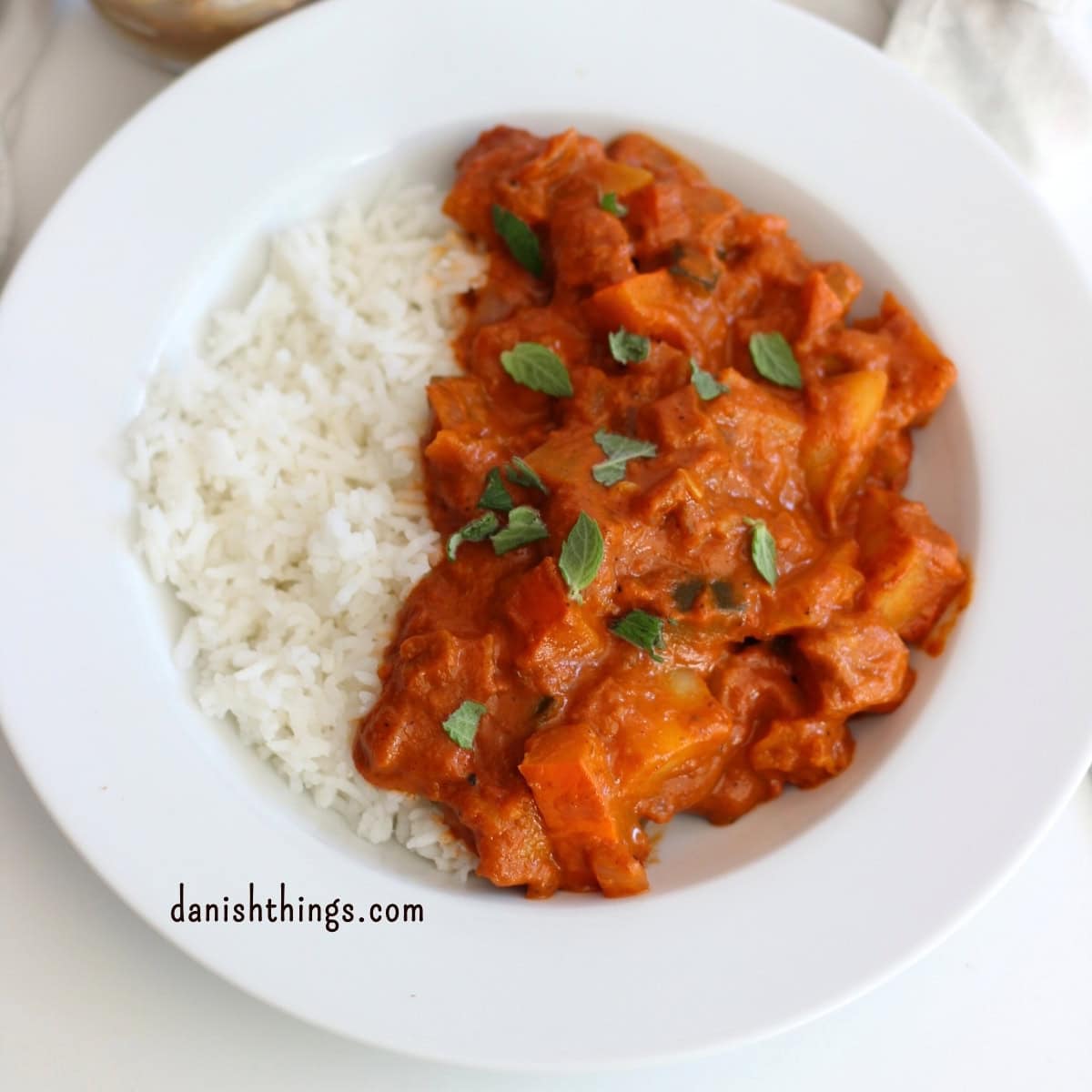
Spices
The flavour in a curry is shaped by the spices – and in this recipe, I use a blend of garam masala, cumin, ground coriander, and chilli.
I adjust the amount of spices depending on the mood – sometimes I want a mild curry, other times I prefer a bit more punch.
Start with the smallest amount of spices; you can always add more.
There’s a lot of variation between garam masala blends.
If the ingredient order differs from the suggestion below, I adjust the other spices to suit my taste.
If you don’t have garam masala, use a mix of ground coriander, cumin, ginger, nutmeg, pepper, cloves, and cinnamon – or another Indian spice blend you enjoy.
By varying both the spices and the filling, you can make curries several times a month without ever getting tired of the dish.

Seasonal Curry Suggestions
Here are some ideas for adapting the vegetable profile in your curry to match Danish seasonal produce.
If you’re in another country, use what’s fresh and available in your local shops or markets.
The seasonal overview is based on Tænk’s guide (in Danish).
I haven’t yet tested all seasonal variations – so feel free to use these suggestions as inspiration and adjust according to taste and availability.
Also check the three tables – there are many more possible combinations.
Autumn Curry 🍂
See the recipe for potato curry with pumpkin and courgette.
Winter Curry ❄
Pumpkin (Hokkaido) is in season and can be supplemented or replaced with celeriac (★★★)
Add celeriac a little before the potatoes.
– Adds depth and substance.
Courgette can be replaced with kale (★★★/★)
Let the stalks simmer for longer – add the leaves at the end.
– Adds structure, bitterness, and green colour.
Spring Curry 🌱
Neither pumpkins nor courgettes are in season.
Pumpkin can be replaced with parsnip (★★) and/or parsley root (★★)
Add both along with the potatoes.
– Adds sweetness, body, and a mild earthy note.
Courgette can be replaced with carrot (★★/★)
Add halfway through or later, depending on size.
– Adds colour, sweetness, and firm texture.
Summer Curry ☀
Pumpkin can be replaced with cauliflower (★★)
Add halfway through.
– Adds mild body and absorbs the flavour of the spices.
Courgette is in season – and you can supplement or replace it with fresh tomatoes (★) and/or fresh green peas (★)
Add tomatoes towards the end or use them as part of the liquid; add peas last to preserve their colour.
– Adds acidity, juiciness, freshness, and green colour.
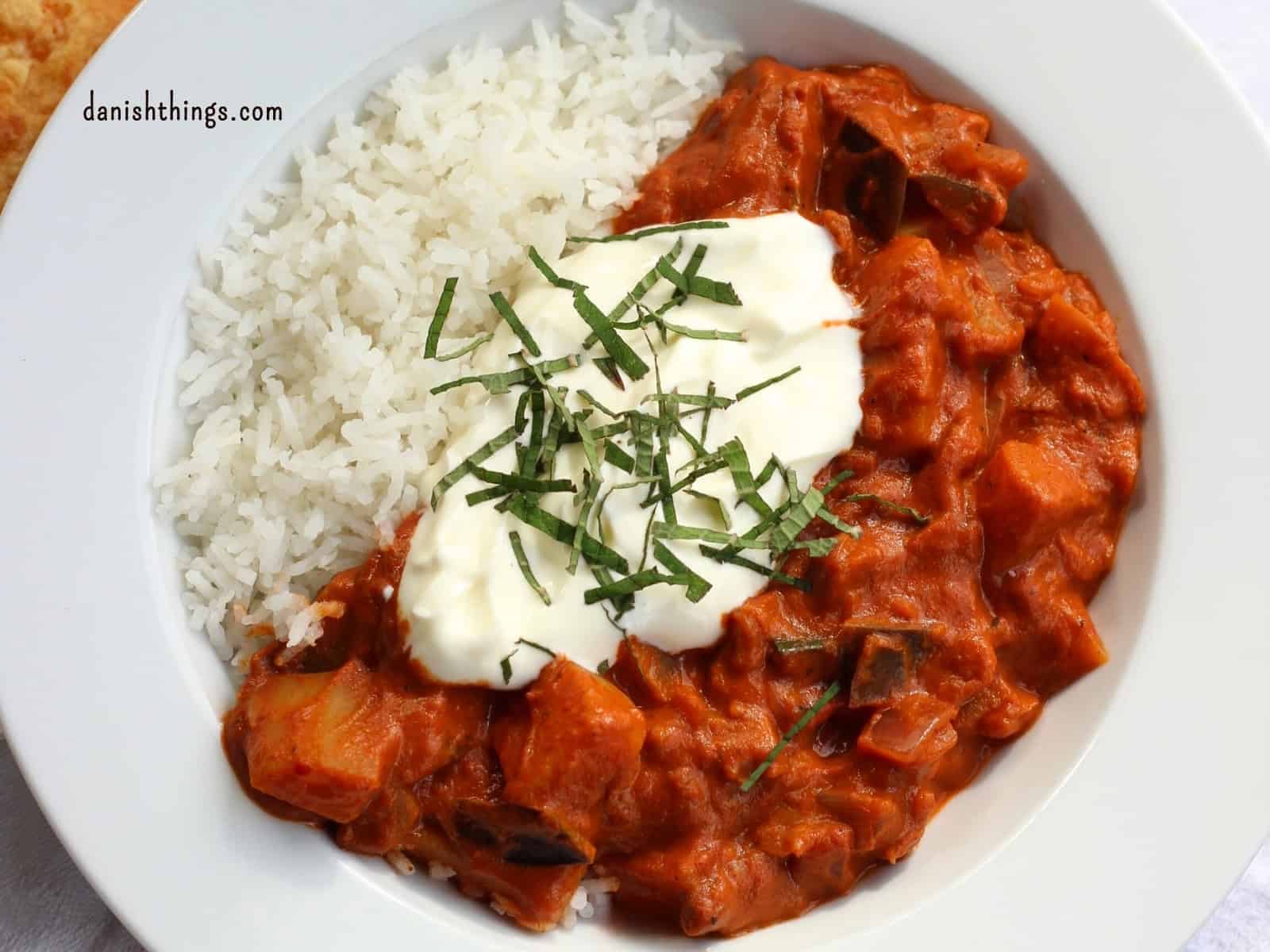
The Recipe: How to make a Potato Curry
Here is the basic recipe – the version I return to again and again.

Potato Curry with Pumpkin and Courgette
Ingredients
- 300 g onions - peeled weight
- 1-2 tsp neutral oil for frying
- 2-3 tbsp garam masala *
- 1-3 tsp cumin *
- 1-3 tsp ground coriander *
- ¼-½ tsp chilli flakes - or fresh chilli to taste *
- 4 tbsp tomato concentrate/tomato purée
- 690 g passata - 1 bottle weighs between 690-700 g
- 400 g coconut milk - full-fat - not light
- 30-40 g water for the bottle/can
- 2 tsp salt
- Freshly ground black pepper
- 1-2 tsp sugar
- 550 g potatoes - peeled **
- 250 g pumpkin - cleaned weight - preferably organic Hokkaido with the skin on for texture **
- 250 g courgette (zucchini) - peeled weight **
- 10-15 g ginger - peeled weight
- + to taste with extra spices, salt, pepper, and sugar
Optional Side Dishes ***
- Rice - choose your favourite
- Flatbreads - ee.g. naan, chapati, or homemade pan-fried breads
- Savoury Pancakes - Indian-inspired
- Greek Yoghurt 10% or raita - you can mix the yoghurt with citrus, fresh herbs, or spices - or make raita
- Chutney - store-bought or homemade - choose mango apple, plum...
- Fresh Herbs - mint, coriander (cilantro), chervil, parsley...
- Papadums, roasted chickpeas, nuts, or seeds
Instructions
- Prepare the onions and dice them. Fry your onions in a small amount of oil 5-7 minutes until translucent.
- Add garam masala, cumin, ground coriander, and chilli - fry for a couple of minutes, stirring.
- Push it aside and fry the tomato concentrate/purée for 1-2 minutes.
- Add the passata and coconut milk - rinse the bottle/can with a little water to get it all.
- Add sugar, salt, and freshly ground black pepper.
- Let it simmer while you wash and prepare the rest of the vegetables, peel the potatoes and ginger.
- Cut the potatoes and pumpkin into suitably sized pieces – dice the courgette. Slice the ginger thinly, then into strips, then finely chop into mini cubes.
- Add the chopped vegetables and finely chopped ginger to the pot - cover with a lid - without turning up the heat if you have plenty of time.
- Otherwise, bring to a boil and simmer for approximately 30-40 minutes, until the vegetables are tender – cooking time depends on dice size.
- Taste and adjust with extra spices, salt, pepper, and sugar.
Notes
** Instead of pumpkin and courgette, you can use other vegetables - e.g., aubergine (eggplant) or cauliflower - see Alternatives to Pumpkin and Courgette. You can also add other vegetables for flavour and variation - see Supplementary Vegetables. Or add lentils or chickpeas for extra protein - see Supplementary Proteins. Even though exact gram amounts are listed, you can use slightly more or less of the potatoes, pumpkin, and courgette - just keep the total quantity consistent. If you're missing vegetables, check the tables above to see if you have one of the alternatives you can supplement with.
*** See serving and side dish suggestions in the text.
If you use US customary units, remember that the recipe is made using Metric and converted via a plugin.
Private notes
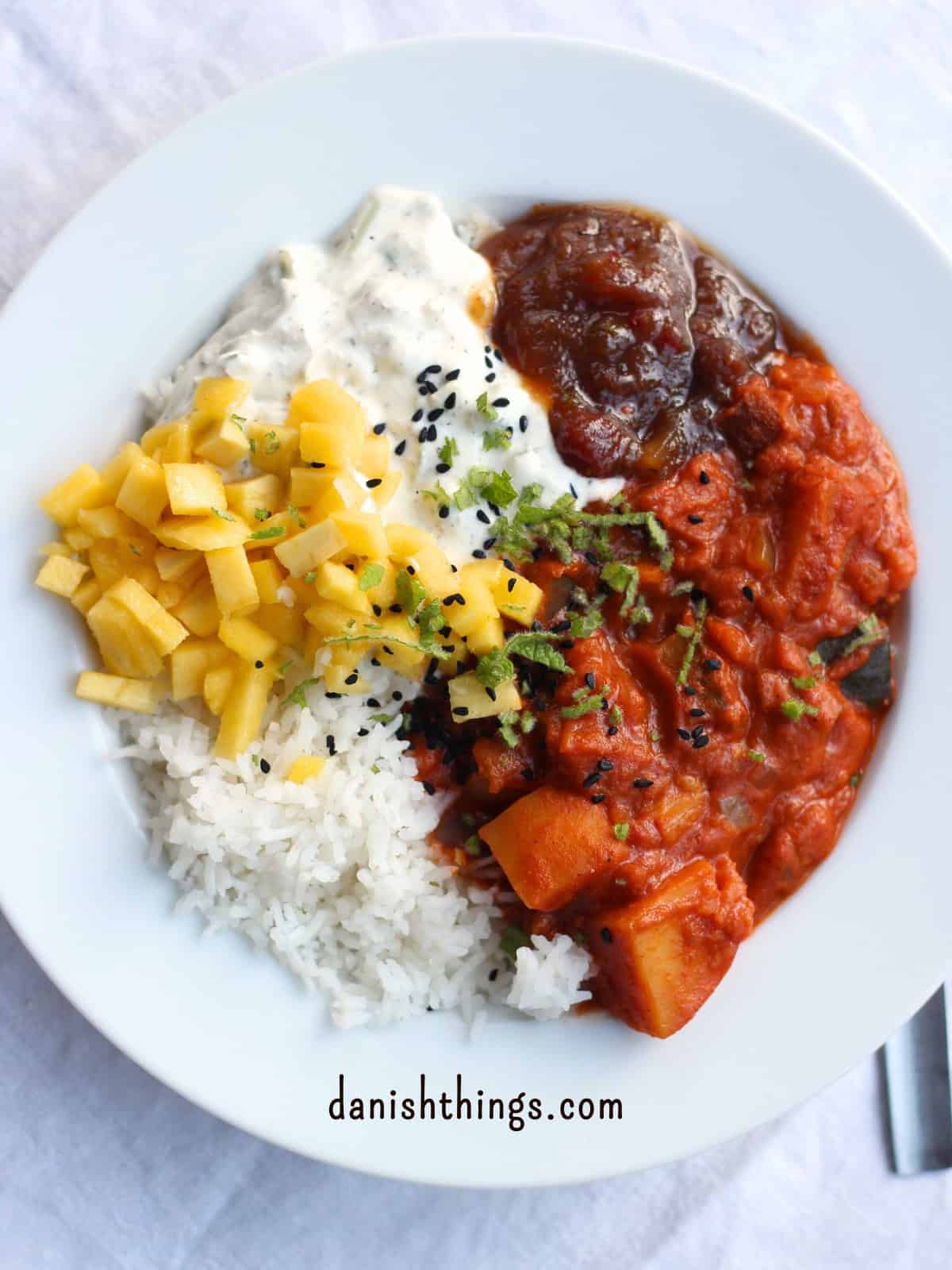
Share Your Favourite Curry
Which potato curry is your favourite?
The one with pumpkin and courgette?
Or are you more into one with aubergines?
How do you make YOUR potato curry seasonal?
Share your pictures and experiences – use @danish_things or #danishthings on Instagram.
And don’t forget to share your favourite combination in the comments below – I’m excited to see your creations! 🍛
